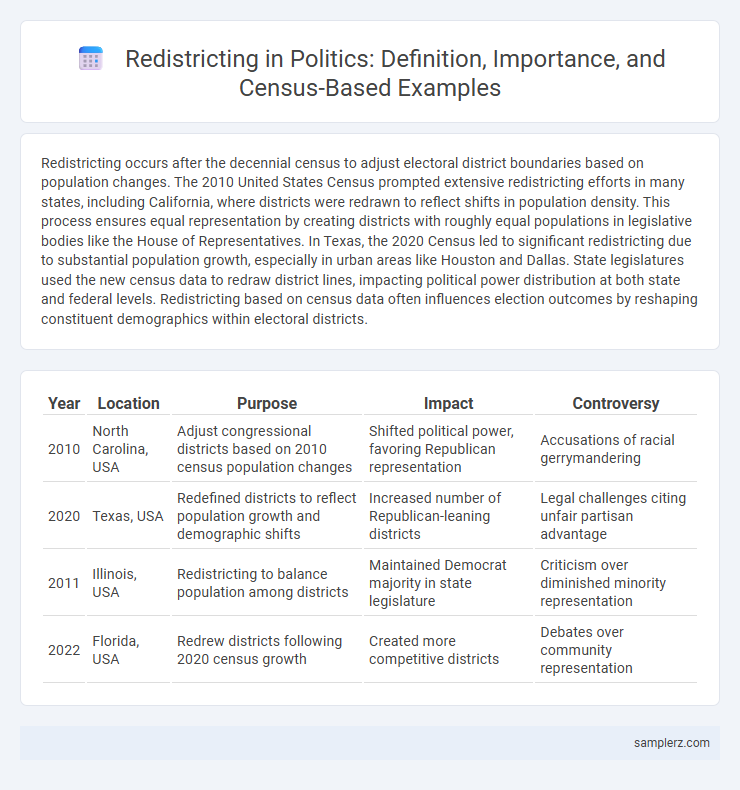Redistricting occurs after the decennial census to adjust electoral district boundaries based on population changes. The 2010 United States Census prompted extensive redistricting efforts in many states, including California, where districts were redrawn to reflect shifts in population density. This process ensures equal representation by creating districts with roughly equal populations in legislative bodies like the House of Representatives. In Texas, the 2020 Census led to significant redistricting due to substantial population growth, especially in urban areas like Houston and Dallas. State legislatures used the new census data to redraw district lines, impacting political power distribution at both state and federal levels. Redistricting based on census data often influences election outcomes by reshaping constituent demographics within electoral districts.
Table of Comparison
| Year | Location | Purpose | Impact | Controversy |
|---|---|---|---|---|
| 2010 | North Carolina, USA | Adjust congressional districts based on 2010 census population changes | Shifted political power, favoring Republican representation | Accusations of racial gerrymandering |
| 2020 | Texas, USA | Redefined districts to reflect population growth and demographic shifts | Increased number of Republican-leaning districts | Legal challenges citing unfair partisan advantage |
| 2011 | Illinois, USA | Redistricting to balance population among districts | Maintained Democrat majority in state legislature | Criticism over diminished minority representation |
| 2022 | Florida, USA | Redrew districts following 2020 census growth | Created more competitive districts | Debates over community representation |
Understanding Redistricting: Definition and Importance in the Census
Redistricting involves redrawing electoral district boundaries based on census data to reflect population changes and ensure equal representation. Accurate census counts are critical for this process, as they determine the allocation of seats in legislative bodies and influence political power distribution. Effective redistricting upholds the principle of "one person, one vote," preventing gerrymandering and promoting fair democratic representation.
Historical Overview: Redistricting Practices in the United States
Redistricting in the United States has historically followed the decennial census to adjust congressional and legislative district boundaries reflecting population shifts. The practice dates back to the early 19th century, with key moments including the controversial Gerrymandering of 1812 in Massachusetts and the establishment of the Voting Rights Act of 1965 that aimed to prevent discriminatory redistricting. Over time, redistricting has evolved into a politically charged process influencing representation and party control at multiple government levels.
The Census Process: How Population Data Drives Redistricting
Population data collected during the decennial census fundamentally shapes redistricting by providing accurate demographic insights that determine legislative district boundaries. The Census Bureau's detailed enumeration ensures representation aligns with shifts in population density, diversity, and growth patterns across states and counties. This precise data helps policymakers redraw districts to uphold equitable representation under the principle of "one person, one vote."
Notable Examples of Redistricting Following Recent Censuses
Following the 2020 Census, key redistricting efforts occurred in states like Texas, California, and Georgia, reflecting significant population shifts and demographic changes. Texas gained multiple congressional seats due to population growth, prompting extensive redraws to accommodate new districts, while California faced legal challenges over boundary adjustments impacting minority representation. Georgia's redistricting highlighted political contention with debates over partisan gerrymandering and compliance with the Voting Rights Act to ensure fair minority voting influence.
Gerrymandering: Political Implications of Redistricting
Gerrymandering occurs when political parties manipulate electoral district boundaries based on census data to favor their candidates, undermining fair representation. This practice distorts voter distribution, often resulting in disproportionate legislative majorities that do not reflect actual population demographics. Legal challenges and reform efforts continue to address the political implications of gerrymandering on democratic processes and election outcomes.
Redistricting Case Study: Texas After the 2020 Census
Texas gained two congressional seats following the 2020 Census, triggering a high-stakes redistricting process that drew significant legal scrutiny. The state's redistricting maps faced multiple lawsuits alleging partisan gerrymandering and minority vote dilution under the Voting Rights Act. These legal challenges highlighted the complex interplay between population shifts, political power, and electoral fairness in Texas politics.
Legal Challenges Associated with Census-Based Redistricting
Census-based redistricting often faces legal challenges related to allegations of gerrymandering, which can infringe upon the Voting Rights Act by diluting minority voting power. Courts frequently examine whether district maps comply with equal population mandates established by the principle of "one person, one vote" from cases such as Reynolds v. Sims. Legal disputes may also arise over the use of partisan data in drawing boundaries, prompting judicial intervention to ensure fair representation and adherence to constitutional standards.
Technology’s Role in Modern Redistricting Techniques
Modern redistricting techniques rely heavily on Geographic Information Systems (GIS) and advanced data analytics to enhance precision and fairness in census-based boundary adjustments. Machine learning algorithms process demographic and voting pattern data, enabling policymakers to create districts that better represent population shifts while minimizing gerrymandering. This integration of technology improves transparency and accountability in the redistricting process, ensuring more equitable political representation.
Public Participation and Transparency in the Redistricting Process
Public participation in the redistricting process enhances transparency and ensures fair representation by involving communities in census data review and map drawing. States like California implement extensive public hearings and online submissions to gather citizen input, fostering accountability and trust. Transparent practices mitigate gerrymandering risks by making draft maps and demographic data publicly accessible for scrutiny.
Future Trends: Reforming Redistricting After the Census
Future trends in redistricting after the census emphasize increased use of independent commissions to reduce partisan gerrymandering and ensure fair representation. Advances in geospatial technology and data analytics enable more precise mapping based on demographic shifts while respecting communities of interest. Legislative reforms aim to enhance transparency and public participation, fostering accountability in the redistricting process nationwide.

example of redistricting in census Infographic
 samplerz.com
samplerz.com